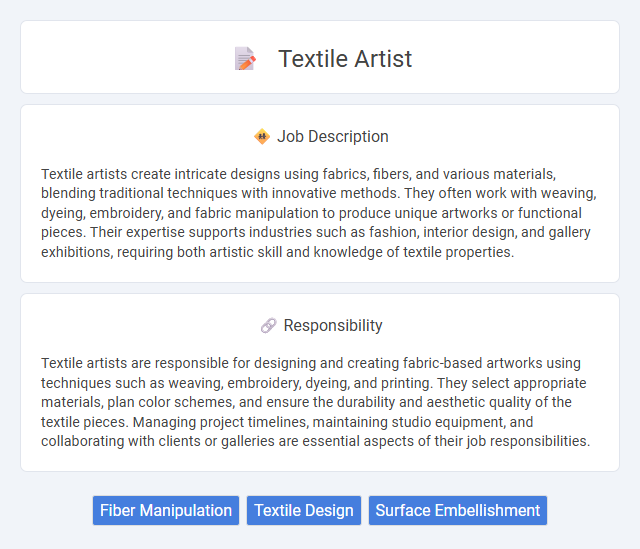
Textile artists create intricate designs using fabrics, fibers, and various materials, blending traditional techniques with innovative methods. They often work with weaving, dyeing, embroidery, and fabric manipulation to produce unique artworks or functional pieces. Their expertise supports industries such as fashion, interior design, and gallery exhibitions, requiring both artistic skill and knowledge of textile properties.
Individuals with a strong appreciation for creativity and patience are likely to find a textile artist job suitable, as it demands attention to detail and an affinity for working with various fabrics and materials. People who enjoy hands-on work and have a passion for design might thrive in this role, while those who prefer fast-paced environments or repetitive tasks may find it less fitting. The physical nature of textile work might not suit individuals with limited dexterity or sensitivity challenges, making personal conditions a probable factor in job suitability.
Qualification
Textile artists typically require a strong foundation in fine arts, with degrees or diplomas in textile design, fiber arts, or fashion design being highly valuable. Mastery of techniques such as weaving, dyeing, embroidery, and fabric manipulation enhances their creative capabilities and marketability. Experience with digital textile printing and knowledge of sustainable materials are increasingly sought after in the industry.
Responsibility
Textile artists are responsible for designing and creating fabric-based artworks using techniques such as weaving, embroidery, dyeing, and printing. They select appropriate materials, plan color schemes, and ensure the durability and aesthetic quality of the textile pieces. Managing project timelines, maintaining studio equipment, and collaborating with clients or galleries are essential aspects of their job responsibilities.
Benefit
A textile artist benefits from a unique blend of creativity and technical skill, which can lead to diverse career opportunities in fashion, interior design, and fine arts. There is a probability of enjoying flexible work environments, including freelance projects or studio work, that encourage artistic expression. Financial rewards may increase with growing recognition and the ability to market distinctive, handcrafted pieces to niche markets.
Challenge
Textile artists often face the challenge of balancing traditional techniques with innovative designs to create unique, marketable works. The complexity of selecting sustainable materials while maintaining artistic integrity may significantly influence project outcomes. Navigating the competitive art market could require continuous adaptation to evolving trends and customer preferences.
Career Advancement
Textile artists enhance their career advancement by mastering advanced weaving, dyeing, and fabric manipulation techniques, which increase their marketability and creative portfolio. Building a strong professional network through exhibitions, collaborations, and industry events opens opportunities for gallery representation and commissioned work. Continuous education in textile technology and staying updated with sustainable materials further position textile artists for leadership roles and innovative project development.
Key Terms
Fiber Manipulation
Fiber manipulation is a core skill in the textile artist profession, involving techniques such as weaving, knitting, felting, and embroidery to transform raw fibers into intricate designs. Expertise in fiber manipulation allows artists to explore texture, structure, and dimensionality, enhancing the tactile and visual appeal of their work. Mastery of various fibers, including wool, silk, cotton, and synthetic materials, is essential for creating innovative and sustainable textile artworks.
Textile Design
Textile artists specializing in textile design create innovative fabric patterns and textures using techniques such as weaving, printing, and embroidery to produce unique materials for fashion, interiors, and industrial applications. They combine creativity with technical skills in color theory, fiber properties, and digital design software to develop textiles that meet aesthetic and functional requirements. Proficiency in trends analysis and sustainable practices enhances their ability to deliver market-relevant and eco-friendly textile solutions.
Surface Embellishment
Surface embellishment in textile artistry involves techniques such as embroidery, applique, beadwork, and fabric painting to enhance fabric textures and visual appeal. Mastery of surface embellishment requires a keen eye for detail, creativity, and proficiency in various hand and machine tools to manipulate fibers and materials. Textile artists specializing in surface embellishment create unique, tactile artworks and functional pieces that blend traditional craftsmanship with contemporary design.
 kuljobs.com
kuljobs.com